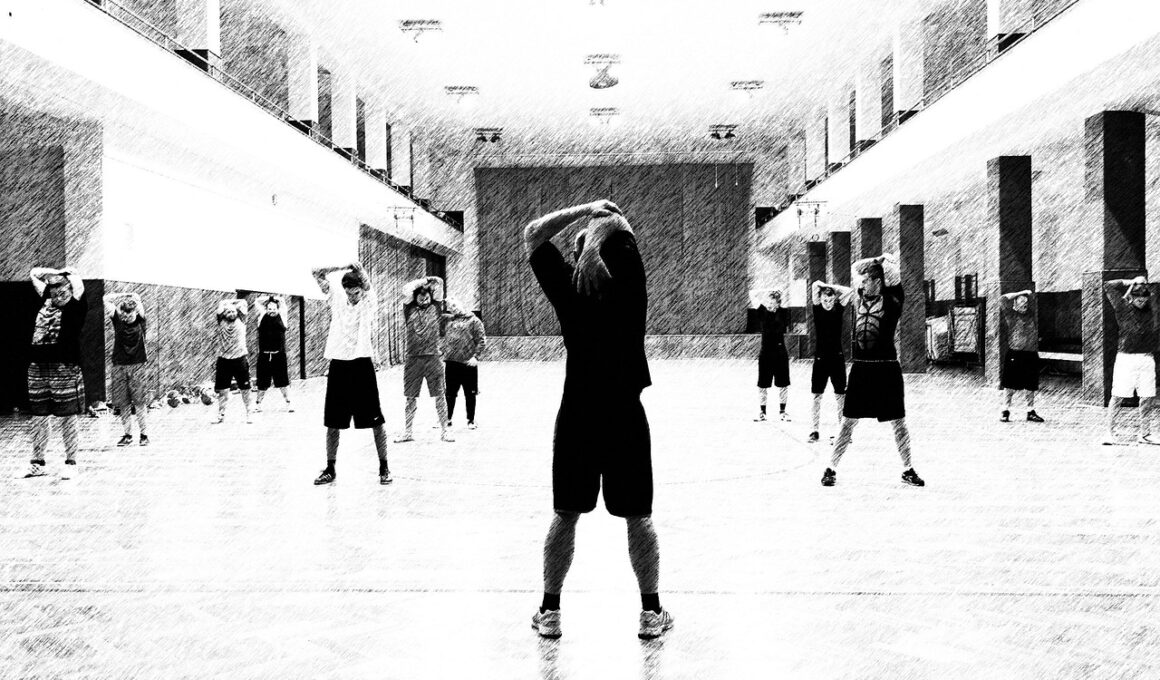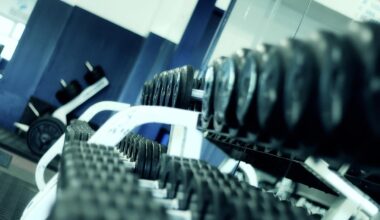Incorporating Stretching and Warm-ups into Your Kickboxing Routine
Kickboxing is an exciting and demanding sport that requires strength, flexibility, and endurance. A critical aspect of any successful kickboxing training routine is incorporating proper stretching and warm-up techniques. Warming up before workouts not only prepares the body but also helps prevent injuries and improves overall performance. Stretching before a kickboxing session enhances muscle elasticity, increases blood flow, and aids flexibility, enabling practitioners to execute techniques more effectively. Indeed, if you’re serious about enhancing your kickboxing skills, prioritizing a well-structured warm-up routine is just as important as practicing your punches and kicks. Additionally, targeting various muscle groups through dynamic stretches is vital for participating in kickboxing training sessions. This increases mobility in joints and makes your body more agile, allowing for faster reactions in the ring. Taking the time to focus on your warm-up exercises can lead to more effective training sessions, enabling you to build stamina and strength over time. Therefore, whether you are a beginner or a seasoned kickboxer, learning about effective warm-up strategies is essential for improving your overall performance and wellness in the sport.
Dynamic stretching should be at the forefront of your warm-up routine before kickboxing training sessions. Activities such as leg swings, arm circles, and hip openers are excellent for preparing the body for the physical demand of kickboxing. These movements progressively elevate the heart rate while enhancing blood flow to the muscles. To begin, ensure that each stretch is performed correctly to prevent any potential injuries. Moreover, dedicating approximately 10 to 15 minutes for dynamic stretching will allow adequate preparation for rigorous training. Studies have shown that implementing dynamic stretches helps athletes achieve better performance outcomes, converting them from static flexibility to functional readiness. In kickboxing, where speed and agility are vital, incorporating dynamic stretches will enhance your ability to move quickly and kick more effectively. After your dynamic warm-up, consider incorporating specific kickboxing drills that mimic the actual movements you will utilize in your training. For example, practicing light shadow boxing can serve as a lead-in to the more intense parts of your session and familiarize your body with the routine. Combining these strategies can significantly improve performance and outcomes in kickboxing training.
Another significant aspect of warming up involves including cardiovascular activities before kickboxing sessions. Engaging in light cardio, such as jogging or skipping rope, raises your heart rate gradually, warming up your body. This increase in heart rate leads to enhanced oxygen delivery to your muscles, helping them perform at their best. Choose a cardio workout that complements your kickboxing training and fits your fitness level. If you’re new to kickboxing, start slowly, allowing your body to acclimate to the movements and routines involved. As you progress, aim to increase the intensity and duration of your cardiovascular warm-up to ensure that your body is prepared for the intensive training that follows. Additionally, combining cardio with stretches will create a comprehensive warm-up routine that sets the stage for a productive kickboxing training session. Remember, taking the time to warm up properly not only boosts your performance but also contributes to a well-rounded fitness experience. Consistently adhering to a warm-up routine is key to realizing lasting improvement in your overall kickboxing skills and physical conditioning.
The Role of Static Stretching After Training
While dynamic stretches and cardio warm-ups are pivotal before kickboxing workouts, static stretching plays a vital role in your post-training routine. After you have completed your kickboxing session, engaging in static stretches can help your muscles relax, enhance flexibility, and reduce soreness. Spending about 10 to 15 minutes on static stretches allows your body to cool down and recover gradually. Focus on the primary muscle groups you’ve utilized during training, such as hamstrings, quads, shoulders, and hips. Hold each stretch for about 15 to 30 seconds, allowing your muscles time to adapt and elongate. In addition, incorporating deep breathing techniques during stretching can enhance relaxation and reduce overall tension in your body. Static stretching also aids in the prevention of injuries by keeping muscle fibers supple and flexible, which is essential for any athlete involved in high-impact sports like kickboxing. Ultimately, integrating a consistent static stretching routine after your kickboxing sessions enhances durability in performing techniques while ensuring longer-term success in achieving fitness goals.
To maximize the benefits of both your warm-up and post-training routines, consider the following tips for effective stretching and warm-ups. First, always opt for a comprehensive routine tailored to your individual needs and goals. Assess your flexibility levels, strength, and any potential areas where you are prone to injury. Secondly, engage in a variety of stretching exercises, including dynamic before and static after kickboxing training. This ensures that all muscle groups are addressed and improves flexibility, strength, and performance overall. Additionally, consistency is key—always incorporate stretching and warm-ups in your training regimen to see significant improvements in your kickboxing skills. Make it a habit so that your body becomes accustomed to the routine. Hydration also plays an essential role in preparing your body for more intense training. Stay hydrated before, during, and after your workouts for optimal performance and recovery. Lastly, listen to your body, and if you notice any pain or discomfort during your warm-up or cooldown, consult with a fitness professional to tailor your routines accordingly. These steps will surely enhance your kickboxing experience!
Investing in the right equipment to aid your warm-up and stretching routines can significantly impact your overall kickboxing training experience. Consider using items such as yoga mats for comfort during floor stretches, foam rollers for muscle recovery, and resistance bands for dynamic stretches and mobility. A yoga mat provides a cushioned surface that helps you perform stretches safely and effectively. Foam rollers assist in releasing muscle tension and enhancing circulation, making them an excellent tool before and after training. Resistance bands, on the other hand, can be incorporated into your dynamic stretching routine, helping you improve range of motion and build strength. This variety can help target specific areas that require more attention and support your overall goals in kickboxing. Moreover, wearing suitable attire that facilitates movement is imperative for your warm-up sessions. Choose breathable, moisture-wicking clothing that allows for full range of motion while ensuring your comfort. Investing in good quality gear for stretching and warm-ups can lead to better outputs in your kickboxing training routines overall.
In conclusion, proper warm-ups and stretches are essential for every kickboxer, whether beginner or seasoned pro. The key to a successful training session lies in adequately preparing the body for strenuous activity and promoting recovery after workouts. By following a structured warm-up routine incorporating dynamic stretches and light cardio, you can enhance your performance while minimizing injury risks. Additionally, integrating a static stretching routine post-training helps maintain the health and flexibility of your muscles, aiding in faster recovery and overall fitness progress. Remember, it’s not just about the intensity of your workouts; it’s equally about how you prepare for and recover from them. As you continue your kickboxing journey, commit to incorporating these essential practices regularly. Doing so can enhance your skills and elevate your performance within the sport. Set achievable goals and be patient with your progress while ensuring you prioritize your physical well-being. As you implement these strategies into your kickboxing trainings, you’ll likely find enjoyment and satisfaction in reaching new heights in your abilities and fitness levels.
In conclusion, proper warm-ups and stretches are essential for every kickboxer, whether beginner or seasoned pro. The key to a successful training session lies in adequately preparing the body for strenuous activity and promoting recovery after workouts. By following a structured warm-up routine incorporating dynamic stretches and light cardio, you can enhance your performance while minimizing injury risks. Additionally, integrating a static stretching routine post-training helps maintain the health and flexibility of your muscles, aiding in faster recovery and overall fitness progress. Remember, it’s not just about the intensity of your workouts; it’s equally about how you prepare for and recover from them. As you continue your kickboxing journey, commit to incorporating these essential practices regularly. Doing so can enhance your skills and elevate your performance within the sport. Set achievable goals and be patient with your progress while ensuring you prioritize your physical well-being. As you implement these strategies into your kickboxing trainings, you’ll likely find enjoyment and satisfaction in reaching new heights in your abilities and fitness levels.


